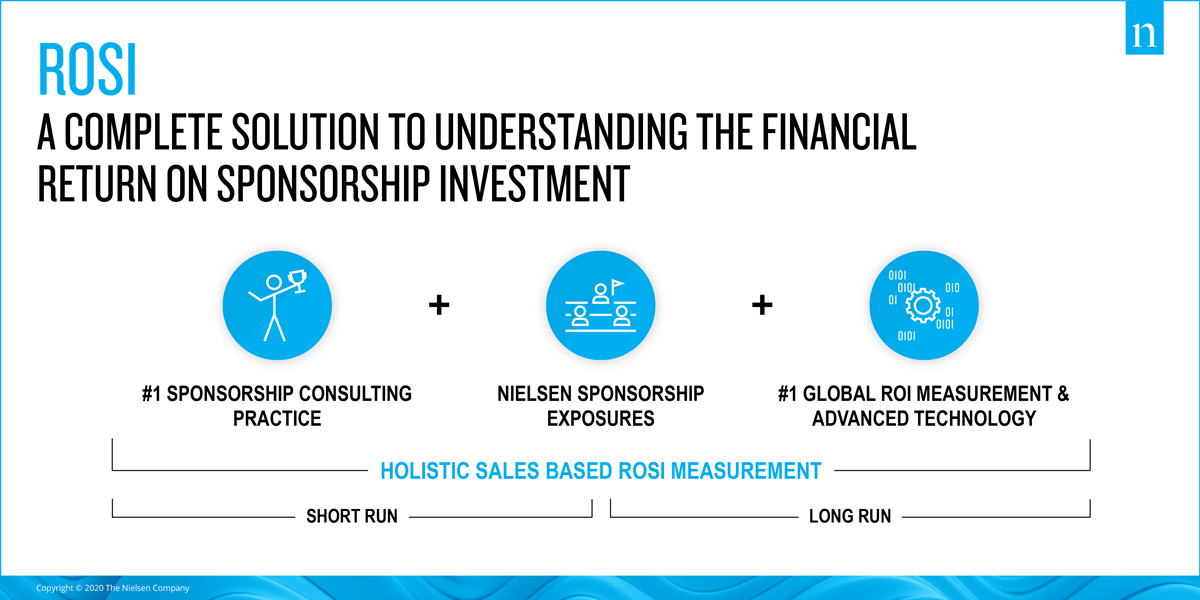
“A New Method of Sponsorship Measurement”
Brands and advertisers spend over $35BN in sponsorship every year only in Europe as they look to leverage the unique association with sport and entertainment platforms within their marketing mix strategies. However, the COVID-19 crisis has accelerated – more so than ever before – the importance of delivering maximum efficiency with reduced investments. Not to mention the increasing importance of measuring sales impact and effectiveness.
Marco Nazzari, Managing Director International, Nielsen Sports explains the importance of sponsorship measurement and how Nielsen’s Return on Sponsorship Investment solution can help brands leverage their sponsorship effectiveness within the marketing mix.
Why is it important for brands to accurately measure the short and long term effectiveness of their sponsorship investments?
“From our conversations with clients, many brands still do not effectively quantify the impact of their sponsorships on brand equity and sales, often neglecting the main component of the bottom line. Our market research shows that on average, sponsorship spend is 15% of the total marketing budget, representing a significant blind spot in the marketing mix. Brands that do try to measure the impact of sponsorship often use inaccurate data or models resulting in a 68% potential error in ROI. Additionally, many marketing executives are ignoring the long term impact of these investments on sales, which represents 47% of the total sponsorship impact, thereby significantly understating ROI.”
How can Nielsen Sports help brands optimize their sponsorship investments and increase the long term sales impact?
“Nielsen Sports has been helping brands for years with our Return on Sponsorship Investment (ROSI) framework which measures the holistic sponsorship impact across a brands’ entire portfolio, making it easy to understand which assets and investments have the highest return. We’ve recently updated our ROSI model to include long-term sales impact for a clearer comparison of sponsorship ROI vs other components of the marketing mix. ROSI measures sales impact, brand impact, fan impact, and sponsorship media value weighted against the brands’ business and sponsorship objectives. Our team at Nielsen helps contextualize this data and provides recommendations to increase sponsorship impact on sales.”

What benefits can brands expect from the ROSI framework?
“We created a new and innovative method of sponsorship measurement. The biggest benefit is our holistic data approach: Nielsen Sports is the only company worldwide that has such a solid background in media and consumer behavior measurement. This means we help brands measuring their visibility, awareness, and sales results, and combine all these different data sources into our ROSI model.
ROSI allows brands to compare short and long-term sales impact and ROI to better allocate marketing spend, enabling growth and reducing waste in sponsorship investment. Our models uncover which properties are driving sales and which properties are underperforming. Additionally, ROSI helps compare sponsorship ROI to other areas in the marketing mix. For example, brands can adjust their marketing mix if they find sponsorship has a greater effect on sales than, let’s say, traditional TV advertising or point-of-sale activations. Our consultants help brands adjust sponsorship budgets to achieve the maximum sales impact”
Why should brands invest in the ROSI model?
“Major sponsorships aren’t a short-term investment, they are strategic decisions with mid and long-term objectives. The effects of a sponsorship and impact on sales can be felt for years. Brand executives need comprehensive data throughout theRemove featured image sponsorship lifecycle to optimize activations and investments. More CEO’s and CFO’s are requiring proof of the correlation between sponsorship and sales; ROSI provides clear data to drive an effective marketing mix.”